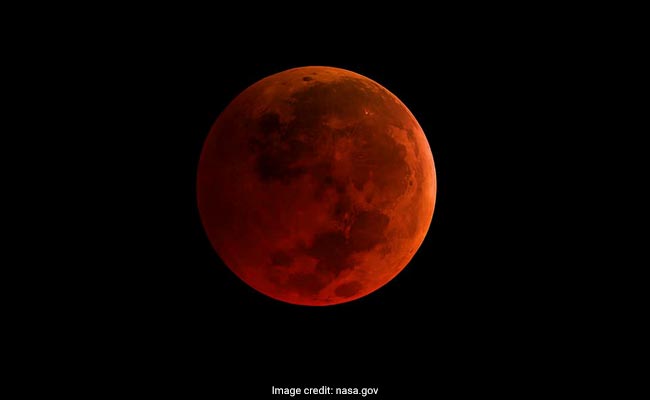
*Picture credit nasa.gov
More than three years ago Jane J.Lee wrote an article on lunar eclipse and it was published by National Geographic on April 14,2014. "Marauding demons, murderous pets, and ravenous jaguars are just some of he culprits that cultures around the world have blamed for the moon's disappearance during lunar eclipses",he wrote.
Today when the sky lovers are excited for the extra terristrial triple treat to be witnessed in the sky and record a super blue blood moon at various locations across the country,www.jharkhandstatenews.com is thankful to its author Jane J.Lee and National Geographic.In any case sky enthusiasts have taken out their telescopes and booked a cosy place on their terrace or garden to watch this celestial spectacle.
However,on April 14,2014,Jane J.Lee wrote in National Geographic this :
"While such celestial events are celebrated today with viewing parties, road trips, and astronomy talks, eclipses haven't always been events that people looked forward to.
Many ancient cultures saw solar or lunar eclipses as a challenge to the normal order of things, says E. C. Krupp, director of the Griffith Observatory in Los Angeles, California. "Things that shouldn't be happening are happening."
"Howling at the Moon"
"[The Inca] didn't see eclipses as being anything at all good," says David Dearborn, a researcher at the Lawrence Livermore National Laboratory in California, who has written extensively on how the Inca viewed astronomy. Accounts written by Spanish settlers in the New World record the Incan practices surrounding eclipses, he says.
Among the collected myths is a story about a jaguar that attacked and ate the moon. The big cat's assault explained the rusty or blood-red color that the moon often turned during a total lunar eclipse. (See "Lunar Eclipse Pictures: When the Moon Goes Red.")
The Inca feared that after it attacked the moon, the jaguar would crash to Earth to eat people, Dearborn says. To prevent that, they would try to drive the predator away by shaking spears at the moon and making a lot of noise, including beating their dogs to make them howl and bark. (Read about the Inca Empire in National Geographic magazine.)
A Substitute King
The ancient Mesopotamians also saw lunar eclipses as an assault on the moon, says Krupp. But in their stories, the assailants were seven demons.
Traditional cultures linked what happened in the sky to circumstances on Earth, he says. And because the king represented the land in Mesopotamian culture, the people viewed a lunar eclipse as an assault on their king. "We know from written records [that Mesopotamians] had a reasonable ability to predict lunar eclipses," says Krupp. So in anticipation of an eclipse, they would install a surrogate king intended to bear the brunt of any attack.
"Typically, the person declared to be king would be someone expendable," Krupp says. Though the substitute wasn't really in charge, he would be treated well during the eclipse period, while the actual king masqueraded as an ordinary citizen. Once the eclipse passed, "as you might expect, the substitute kings typically disappeared," Krupp says, and may have been dispatched by poisoning.
Healing the Moon
The eclipse myth told by the Hupa, a Native American tribe from northern California, has a happier ending.
The Hupa believed the moon had 20 wives and a lot of pets, says Krupp. Most of those pets were mountain lions and snakes, and when the moon didn't bring them enough food to eat, they attacked and made him bleed. The eclipse would end when the moon's wives would come in to protect him, collecting his blood and restoring him to health, Krupp says.
To the Luiseño tribe of southern California, an eclipse signaled that the moon was ill, says Krupp. It was tribe members' job to sing chants or prayers to bring it back to health.
Modern Myths
Not all cultures view an eclipse as a bad thing, says Jarita Holbrook, a cultural astronomer at the University of the Western Cape in Bellville, South Africa, in an interview last year.
"My favorite myth is from the Batammaliba people in Togo and Benin" in Africa, she says. In this myth, the sun and the moon are fighting during an eclipse, and the people encourage them to stop. "They see it as a time of coming together and resolving old feuds and anger," Holbrook says. "It's a myth that has held to this day."
Ancient rituals will mingle with contemporary science as the Griffith Observatory marks the April 14-15 eclipse. "Based on past experience, we expect a very large crowd to show up," Krupp says, as staff and astronomers gather on the Los Angeles observatory's front lawn with telescopes—and with noisemakers.
"If there's a celestial object threatened, Griffith Observatory is in the business of protecting and observing," Krupp says with mock gravity. He plans to don his "official eclipse-dispersing wizard's robe and hat" and lead marchers around the lawn with noisemakers, to scare off whatever is swallowing the moon.


